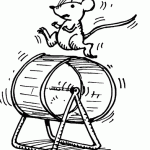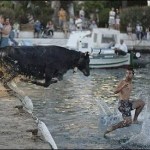running
The Arizona Physiological Society held their 8th annual conference Nov 13-14 at Midwestern University in Glendale. This was a great meeting for comparative physiologists!
Here are some comparative physiology highlights from the meeting:
The 2015 Keynote Speaker was Dr. Andrew Biewener (Harvard University) who spoke about "How do running animals acheive stability? The neuromechanical control of rapid locomotion." In his talk he focused on understanding how Guinea fowl avoid tripping when running really fast over uneven surfaces.
The 2015 Arizona Distinguished Lecture was given by Dr.…
Cartoon image from www.teenwritersblog.com
Physiologist Laurie Goodyear (Joslin Diabetes Center, Harvard Medical School, MA) and her colleagues recently published a study in the American Journal of Physiology that shows how overexpressing a protein can increase exercise capacity. The protein of interest was tribbles homolog 3 (TRB3), which is a mammalian form of the tribbles protein found in fruit flies (aka: Drosophila). Prior to this study, data suggested that TRB3 plays a role in metabolism so Dr. Goodyear's team decided to examine this more closely in skeletal muscle, which is a major…
Just like 2011 or 2012 but faster! TL;DR: 3:43:06. Just 5 minutes faster and I'll only be an hour slower than Maz. This post is mostly for my records. Transport and accommodation just like before, except I had Miranda with me.
As you can see, Amsterdam has some exciting architecture.
My GPS track is here, or at least a bit of it is. Turning it on as I went in to the stadium I realised I hadn't bothered to charge up the battery. Oops, though its perhaps nice that I'm getting rather casual about things I'd once have obsessed over. So the track contains the first ~16k, and the last ~4k. The…
The follow-up to Amsterdam and Brighton part 1. Again, if you lack interest in running, the answer is 3:54.28.
The photo is me and James Edgoose after the finish. By this point we've gone through the phases of collapsed in a heap for a bit, drunk some water, eaten a banana, just about got up, walked a bit, sat down again, got up and are capable of smiling... well you get the idea. And I can only speak for my own collapse, James finished 15+ mins ahead of me so may have been all sparkly at the finish for all I know.
This year was much better than Brighton last year, but only a bit (3 mins)…
The long-awaited follow-up to Brighton man and about as exciting for non-runners. If you lack patience, the answer is 3:57.
Long introduction - you can skip this bit
Just like last time, there is a backstory: after Brighton, I'd decided I was going to do more of this nonsense, and so inscribed again. But next April was a long way away, so I thought I'd see how two a year worked. I looked around and found a new local race, Grafham water marathon in September, and signed up for that. Closer to the time I realised that the all-important Boston marathon was on the same day. Rats: so I cancelled…
A running post I'm afraid. I don't think I promised to move them all across.
Courtesy of the generous Maz the Merciless I have a pair of "footgloves" wot am all de rage, or at least they were all de rage a year ago or somesuch. Naturally, I'm late to the party. Today I gave them my first try-out, a 5 km run round the local "countryside reserve". They are really called "five fingers" (of VFF's, as the hip cats say); as they say: we recommend wearing Vibram FiveFingers for exercise, play, and for fun. Stimulating the muscles in your feet and lower legs will not only make you stronger and…
[Warning: more boring fitness-related content. This is the penultimate post on such, before moving the misc trivia over to wmconnolley.livejournal.com/. The science will stay here.]
Saturday-before-last James E said that the Grunty Fen half marathon was on the 12th; and being a little unsober I signed up online an hour later. Next morning I thought I'd better check that I could actually run the distance, and it turned out that I could. Or at least, nearly. I accidentally ran 20 km instead of 21.1, because I forgot the true distance. Oops. Anyway, that took me 1:51, which seemed fair enough…
Or rather, Parkrun which D+A introduced me to. Thats me, the one on the right: I wanted to be that dog, at least for the race. It looks so focussed and determined, even if it is just chasing a stuffed electric hare.
And the running is good, so I'll tell you all about it so you can play too. It is a series of regular free 5km runs at various places in the UK. You have to pre-register a tag, but from then on you just turn up at the start and run. The Cambridge one is in Milton Country Park which is where I run at lunchtime, though on a different course.
The results are now up: I came an…
Bumps is over, so tis the season for off-the-river exercise again. Yes, I know that no-one but me cares about this but it is *my* blog.
30 minute erg, heart rate. Split varying from 1:56 to 2:00 for most of it, down to 1:39 just before the line (yes I know: it means I should have pusehed earlier), distance 7582, so overall split around 1:59. Sadly no speeds on this - the watch got confused since I was wiggling back and forth in place.
Lunchtime run with Ian. 3 laps of Milton Country Park, last lap alone and faster (note it is plotting pace not speed), peak heart rate on the "sprint" coming…
I have a funky new watch, a Garmin Forerunner 110. It lets me do kewl stuff like:
although you only get that after post-processing, of course. In fact I haven't even worked out how to make it work like a GPS when running, i.e. display lat/long or grid refs. Nor have I worked out how to persuade the stupid post-processing software to give me mph instead of mins/mile like all the hard-core runners want, pah. But the upload-from-watch (via the provided nipple clamp) to-web-and-graph is impressively smooth and painless.
You're fascinated - I know - so let me tell you that we did two laps: the…
This video seems like it is getting popular, but maybe that is because it is so awesome.
Maybe it is just me, but I find this video very visually satisfying. I love the way they compare the different runners.
Anyway, there is some physics here. Commenter Ben sent me the link to this video (thanks!) with some great questions. Which of the runners has a greater kinetic energy? What about the power? These aren't too difficult to answer, but the first thing is to get the data. There are several options (including just using a stop watch). But no, that is not good enough for me. Instead, I…
tags: kinematics, kinetics, running,The Barefoot Professor, exercise physiology, barefoot running, NPG, peer-reviewed research, NATURE, 10.1038/nature08723, streaming video
Harvard professor Daniel Lieberman ditched his trainers and started running barefoot. His research shows that barefoot runners, who tend to land on their fore-foot, generate less impact shock than runners in sports shoes who land heel first. This makes barefoot running comfortable and could minimize running-related injuries.
This video is interesting to me because I was a cross-country runner and later, a long-distance…
Wired has a piece up To Run Better, Start by Ditching Your Nikes, which discusses the controversy over the utility of running shoes. Of course the "support" that typical athletic shoes provide is real. when I switch to flip-flops in warm weather it takes a few days to get comfortable walking up or down hills. There is a shift in the emphasis of which tendons you have to work.
Stupid BoingBoing always has the best stuff. Reminds me of my puppy when he escapes out of the door.
Once again, thanks to that Asian guy we know.
Clearly, neither the man nor the bull below is headed for anything good in their attempt to walk on water,
and for that matter, neither is this poor, bristling cat,
but what about this reptile?
Unbelievably, this lizard actually can walk on water! And without using any surface tension tricks like insects do, either. No, whereas a human puts his foot into the water and sinks, this lizard has a very low mass and a very large surface area on his feet, allowing him to "run" on water as long as he moves quickly enough. For this lizard, that's about 10 miles-per-hour. As opposed to a human, who…

